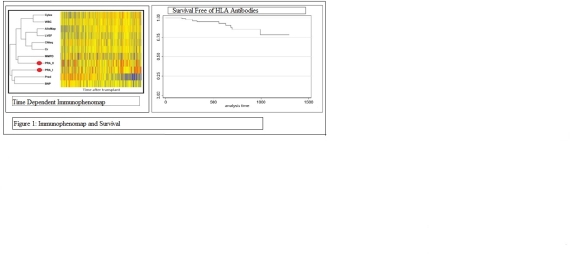Predicting Emergence of Anti-HLA Class I and II Antibodies by Time Dependent Phenomapping in Heart Transplant Patients.
Cardiology, University of California-Los Angeles, Los Angeles, CA.
Meeting: 2016 American Transplant Congress
Abstract number: B155
Keywords: Heart transplant patients, HLA antibodies, Immunosuppression
Session Information
Session Name: Poster Session B: Hearts and VADs in Depth - The Force Awakens
Session Type: Poster Session
Date: Sunday, June 12, 2016
Session Time: 6:00pm-7:00pm
 Presentation Time: 6:00pm-7:00pm
Presentation Time: 6:00pm-7:00pm
Location: Halls C&D
Purpose: The presence of circulating HLA antibodies which is termed allosensitization among heart transplant (HTx) candidates are associated with poorer posttransplant outcomes including increased morbidity and mortality. We hypothesize that time dependent characterization of clinical phenotypes by immunophenomapping enables clinicians to identify predictors of allosensitization post HTx.
Methods: We collected clinical variables including BNP, Cylex, Allomap, and immunosuppressant levels from more than 600 encounters of 108 HTx patients. We constructed a mixed-effects, time dependent regression and cubical model time since transplant and fitted to data with interaction term for new or re-emerged anti-HLA class I and II antibodies which was defined as greater than 15% panel reactive antibodies (HLA+ group).
Results: Fourteen patients (13%) met greater than 15% reactive antibody criteria with mean time to event of 212 days post HTx with no statistically significant differences observed in baseline characteristics. Immunophenomap revealed a steeper slope of mycophenolate dose, higher slope of prednisone and CNI in HLA+ group. Association of slopes with time to HLA+ depicted in Figure 1. Our analysis showed that BNP levels were also associated with HLA+. Visualization using cluster analysis evidenced a mechanistic link between immunosuppression management CD4 T-cell function and presence of greater than 15% HLA antibodies. The association of slopes with time to HLA+ depicted in Figure 1.
Conclusion: Phenomapping of time dependent immune response and mixed effect model allows for predicting events underlying the emergence of anti-HLA antibodies which are associated with poorer long-term outcomes among heart transplant patients. While our data demonstrates value of large datasets to improve management of HTx, our results require further validation.

CITATION INFORMATION: Bakir M, Jackson N, Chang E, Henriquez-Ticas D, Tseng C.-H, Khuu T, Zhang J, Reed E, Deng M, Cadeiras M. Predicting Emergence of Anti-HLA Class I and II Antibodies by Time Dependent Phenomapping in Heart Transplant Patients. Am J Transplant. 2016;16 (suppl 3).
To cite this abstract in AMA style:
Bakir M, Jackson N, Chang E, Henriquez-Ticas D, Tseng C-H, Khuu T, Zhang J, Reed E, Deng M, Cadeiras M. Predicting Emergence of Anti-HLA Class I and II Antibodies by Time Dependent Phenomapping in Heart Transplant Patients. [abstract]. Am J Transplant. 2016; 16 (suppl 3). https://atcmeetingabstracts.com/abstract/predicting-emergence-of-anti-hla-class-i-and-ii-antibodies-by-time-dependent-phenomapping-in-heart-transplant-patients/. Accessed December 19, 2025.« Back to 2016 American Transplant Congress
